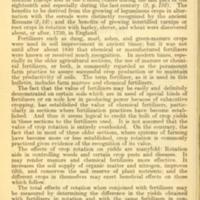A Study of the Value of Crop Rotation in Relation to Soil Productivity
Creator
Date
1926
Subject
Excerpt
Two methods have been employed in evaluating the effectiveness of rotation in crop production, and in determining the additive effects of rotation and the use of fertilizers when these two farm practices are conjoined. Although in one method the evaluations are based on the increases over the yields obtained on check plots in continuous culture and in rotation, and in the second method, on the increases over the maintenance yield; or the average yield obtained at the beginning of the experiments, yet the general results as regards the value of rotation in relation to soil productivity all point in the same direction.
The evaluation of crop rotation as calculated from the maintenance yield seems to be the more logical and scientific method, especially from the point of view of maintaining and increasing the producing power of the soil. However, in determining the values for rotation and the use of fertilizer when one practice is combined with the other, or in determining the relative value of R. the first method referred to above has been found to be very useful.
Taking all the results into consideration, as based on the average results of the published data of the long-time fertility experiments herein considered, the following important facts as regards the value of crop rotation have been brought out:
(1) Rotation of crops is practically 75 per cent as effective as the use of fertilizer in effecting increases in crop yields — being nearly 90 per cent as effective as the use of fertilizer when the results on wheat, corn, and oats, only, are considered.
(2) As based on the, average yields at the beginning of the experiments involving fully comparable yields, rotation has been shown to be 91.5 per cent as effective as the use of fertilizer in maintaining the producing power of the soil.
(3) In increasing soil productivity, the effects of rotation alone may equal or exceed the effects of the use of fertilizer without rotation.
(4) The effects of rotation and the use of fertilizer apparently are not the same, as is shown by the fact that their conjoint effects on crop yields are additive — being more than fully additive in most of the cases considered.
(5) In permanent crop production, high productivity levels are possible only when rotation and the use of fertilizer are conjoined.
The evaluation of crop rotation as calculated from the maintenance yield seems to be the more logical and scientific method, especially from the point of view of maintaining and increasing the producing power of the soil. However, in determining the values for rotation and the use of fertilizer when one practice is combined with the other, or in determining the relative value of R. the first method referred to above has been found to be very useful.
Taking all the results into consideration, as based on the average results of the published data of the long-time fertility experiments herein considered, the following important facts as regards the value of crop rotation have been brought out:
(1) Rotation of crops is practically 75 per cent as effective as the use of fertilizer in effecting increases in crop yields — being nearly 90 per cent as effective as the use of fertilizer when the results on wheat, corn, and oats, only, are considered.
(2) As based on the, average yields at the beginning of the experiments involving fully comparable yields, rotation has been shown to be 91.5 per cent as effective as the use of fertilizer in maintaining the producing power of the soil.
(3) In increasing soil productivity, the effects of rotation alone may equal or exceed the effects of the use of fertilizer without rotation.
(4) The effects of rotation and the use of fertilizer apparently are not the same, as is shown by the fact that their conjoint effects on crop yields are additive — being more than fully additive in most of the cases considered.
(5) In permanent crop production, high productivity levels are possible only when rotation and the use of fertilizer are conjoined.
Title
A Study of the Value of Crop Rotation in Relation to Soil Productivity
File(s)
A Study of the Value of Crop Rotation Cover.jpg
(image/jpeg)
A Study of the Value of Crop Rotation 1.jpg
(image/jpeg)
A Study of the Value of Crop Rotation 2.jpg
(image/jpeg)
 An official website of the United States government.
An official website of the United States government.




